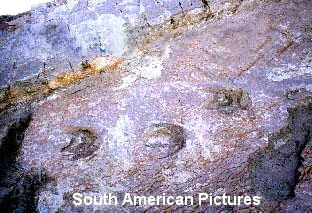The
dinosaur story began over 190 million years ago when the world was simple. Just
one supercontinent existed with Gondwanaland in the south and Laurasia in the
north in which the lizard-like ancestors of a whole zoo of curious reptiles
including the dinosaurs had evolved. The simplest name for them was thecodonts
or socket toothed but that has been superceded by finer classification. These
animals which had longer hind limbs than fore limbs and some probably walked on
just two, were the ancestors of several lines of succesful reptiles. Moving on
by a huge leap of time we can see how the movement of the Earth's massive crustal
plates began to separate South America and Africa about 130 million years ago.
The Andes mountains had not even begun to form and many of the species we know
today had not evolved. It was an age when reptiles ruled the Earth. By about 100
million years ago the 'reptile age' was going well for the reptiles and they had
evolved as many different forms of beast: some as plant eaters, some as meat eaters,
some running, some in the seas, some flying and even the first bird-like creature
with primitive feathers was about. Dinosaurs
were a highly successful land-living group of these ancient reptiles and they
roamed over great plains. Not all the dinosaurs were large and while some reached
80 tonnes or the weight of about twenty modern day elephants, others were no more
than the size of a mistle thrush. Their home was a spectacularly primitive world
studded with tall trees with branching stems. These were peculiar trees with small
leaves and were the ancestors of present-day pines. The scene was quite unlike
anything near Sucre today. The
footprints at Cal Orko come from near the the end of the dinosaur era which was
relatively abrupt at about 65 million years ago. There have been countless theories
for the 'great extinction' of these extraordinary animals and it is to be hoped
that on-going studies of the dinosaur traces in Bolivia may help solve the mystery CLICK
HERE TO SEE THE FOOTPRINTS 
|